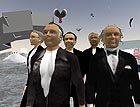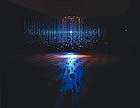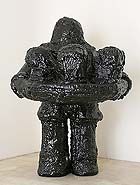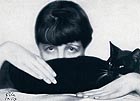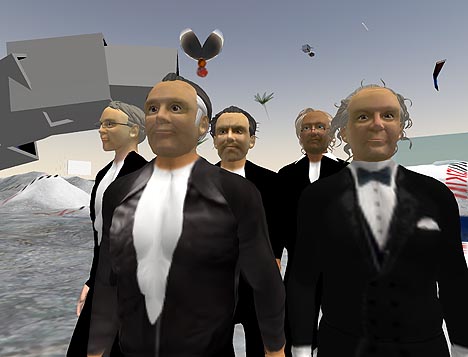
translated and summarized by: Liz Wollner-Grandville,
English summary July 7 - 14
ZKM – Zentrum für Kunst und Medientechnologie: YOU_ser: The consumer’s century
You are the user
“YOU_ser: The consumer’s century” offers an insight into the permanent collection and what one would generally describe as “new media”. It is not a temporary exhibit, but more like another chapter of the cyclopaedic question with which the ZKM attempts to translate the overriding museum-concept into the next millennium.
Mass communication via the Internet, so one believes, represents both the participation and the reciprocal impact as a kind of culture for everyone. Numerous installations are constructed in such a way, that they save the diverse activities of the visitors on the World Wide Web, from where they are retransmitted into the museum with a beamer-projection. A good example for this is Peter Weibel’s and Matthias Gommel’s “FLICK_KA-Project”: an automated camera device positioned in the foyer sends photos to the Internet, and by using the detour of telecommunication, they find their way back to exhibit – presented in monumental dimensions.
Ludger Brömmer’s “Pattern Machine” and Götz Dipper’s “Mozart Würfel” (Mozart Cube) allow the visitor to feel like a composer: one can choose beats or audio sequels from a limited number of music-modules, and receive unlimited possibilities to generate music. Or one can feel like the participant at a huge symposium and follow the discussions as an oversized projection on the wall.
The exhibit wants to transmit the feeling that logging-in and chatting is a creative act. The ZKM has the ability to transform every visitor into a user. And it also believes that the reverse is true: every user is a visitor of the museum: how many spams and postings would be necessary to refute this?
ZKM – Zentrum für Kunst und Medientechnologie
76135 Karlsruhe, Lorenzstrasse 19, until 16. 01. 2009
www.zkm.de
BAWAG Foundation: Susan Hiller – Outlaw cowgirl and other works
Targeted towards the collective unconscious
The cowgirl in her Sunday dress holds a gun in her right hand. The barrel in her left diagonally juts out of the black and white photo. Under the photo is a small kitchen shelf with four small porcelain cows. One of them is completely shattered - as if it had been hit by one of the bullets from her gun. The depiction of this determined woman destroys a realistic kitsch-figure. And this is the central theme of Hiller’s entire oeuvre: the entanglement of presentation and imagination on the one hand, and the exclusions, which produce visibility, on the other.
The glass showcase “From the Freud Museum” takes up an entire wall (1991 – 1997) and is filled with boxes, in which the London-based artist has set objects, resembling ethnographic discoveries. The Freudian motif is, however, is not the eerie thing about Hiller’s work. When the artist deals with the fascination of horror, it’s more about the social than the psychological process behind it. “Street J. Project” (2002 – 2005) is a documentation about present-day German street signs shown in films, photographs, and books, in which “Jew” is part of the depicted word or phrase. The “Last Silent Movie” (2007), also shown at this year’s Berlin Biennial, shows a collection of languages that are extinct as well as those threatened by extinction. Just recently the media expert Peter Weibel said: art has a special approach to the collective unconscious. Hiller’s works seem to justify this opinion. The gun’s barrel is aiming in that direction.
BAWAG Foundation
1040 Vienna, Foundationsquartier, Wiedner Hauptstr. 15, until 17. 08. 2008
www.bawag-foundation.at
Galerie Krinzinger: Atelier van Lieshout – Life
Meaningful black crust
“Social Utopia”, “Autonomy”, and “alternative life planning” are the buzzwords closely connected to works created by the Atelier van Lieshout (AVL). After the creation of mobile sleeping- and living units, practical approaches to compost toilets and water cleaning systems, founding of the Free State of AVL-Ville as well as many other undertakings, in which individual freedom, equality, independence, as well the balance of power were questioned, the collective created projects in which criticism of the modern achievement-oriented society became increasingly tougher: among them the installations “Disciplinator” and “The Technocrat” stirring up the horror scenario of a labour camp. Humans were represented by modular AVL-men - complacent workers made of fibreglass – and used as a symbol for the uniformity of mass society.
These pitch-black figures were made of polyurethane foam, the same material used for the production of mattresses or insulating material. The human body, which according to AVL amalgamates rationality, efficiency and exploitation, is not detached from its functions in this new oeuvre. Even if individual body parts, intertwined groups of figures, and distinctive objects appear like a sculptural mass and are titled “Wall Decoration”. And not even if AVL offers another version of the “The Kiss”, lets a dead dog hang from a tree in reference to Goya’s “Los Desastres della Guerra” or imputes Virgin Mary with three children.
The actual topics of this exhibit include processes, which are more existential than one could ever imagine. They deal with the body from its procreation, to its birth until death and decay. “Life” -presented under the rigid crust of this material - is ultimately the driving force, and humans are the material, which at times can be broken.
Galerie Krinzinger
1010 Vienna, Seilerstätte 16, until 12. 07. 2008
www.galerie-krinzinger.at
Jewish Museum Vienna: Modernism on the run –Austrian artists in France 1938 – 1945
Flight perspectives
The exhibit “Modernism on the run” clearly shows how the experience of emigration influenced the development and the work of those Austrian artists, who fled to France between 1938 and 1945. Andrea Winklbauer curated the exhibit, following the tracks of 24 artists into exile. Their tracks lead in three stages: from Vienna to Paris, to the Cote d’Azur, and as far as Casablanca, New York, and Mexico.
Pre-war Vienna is omnipresent in this exhibit. Under the glass plates of those typical round Viennese coffee tables, documents the personal life of some of the artists is illustrated. Photos and paintings offer a precise inventory of émigré-life.
Renowned artists such as the surrealist Wolfgang Paalen, the photographers Liesette Model, Dora Kallmus alias D’Ora, and Trude Fleischmann as well as the painters Willy Eisenschitz, Josef Floch and Lilly Steiner are among the artists shown at the current exhibit.
And lesser-known artists such as John H. Popper are also part of the group. One of his photos decorates the catalogue cover: a man at the banks of the river Seine, sitting on the quay wall, with his back turned towards the onlooker, a fishing rod in his hand; the dark reflection of a church’s silhouette in the water; an ink black tree trunk flowing through the picture. On the left, a second fisherman sunk into the dark shade. Another photo shows a homeless person sitting on the wayside – all of these motives are in sharp contrast to the mundane motifs shot by Popper while he was still in Vienna.
Kurt Husnik’s oeuvre, documenting Abel Gance’s work on the set of “J’accuse” and the International Surrealism Collection is also shown. Lilly Ross Reich portrayed Albert Einstein and Fernand Leger and shot the photos of Oswald Haerdtl's Café Viennoise during the world exhibit in Paris. After sadly having lost her eyesight she published her widely acclaimed “Viennese Pastry Cook Book”.
“Modernism on the run” narrates these and many other stories.
Jüdisches Museum Wien
1010 Vienna, Dorotheergasse 11, until 07. 09. 2008
www.jmw.at
Mehr Texte von translated and summarized by: Liz Wollner-Grandville


 Teilen
Teilen

